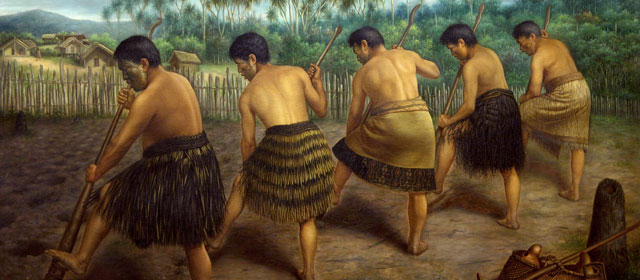Story summary
Plants across the ocean
When the ancestors of Māori arrived in New Zealand, around 1250–1300 CE, they brought plants with them from Polynesia, to grow in their new home for food or other uses.
New Zealand’s climate is cooler than subtropical Polynesia, so the settlers had to change their gardening techniques. Some plants only grew in the warmer months. Māori also added sand and gravel to the soil to warm it and help it drain.
Kūmara (sweet potato)
Kūmara became a major source of food for Māori. They performed many rituals when planting it, which were thought to ensure the crop’s success.
The plants were grown in mounds, and harvested kūmara were stored in underground pits during winter. Early varieties were far smaller than the kūmara we eat today.
Hue (bottle gourd)
Hue was grown for its fruit, which were eaten when small, or made into containers for food or water when large. Hue plants needed moist soil, so they were grown in hollows. The trailing plants may have twined up stakes or over houses.
Aute (paper mulberry)
Aute is a small tree, found throughout Polynesia, where the bark was used to make tapa cloth. It did not do so well in New Zealand, and only small amounts of cloth were produced.
Taro
Taro was sometimes grown in swamps, with drainage channels dug out. The starchy tuber was seen as a special food for chiefs and other important people.
Uwhi (yam)
Yams have a long growing period, and probably did not do well in New Zealand. They were replaced by potatoes and other vegetables brought from Europe.
Tī pore (Pacific cabbage tree)
Tī pore was grown for its root, which was cooked in a hāngī (earth oven) and eaten. It was probably grown only in the far north of New Zealand. Māori also cooked and ate the root of the native New Zealand cabbage tree, but did not cultivate it in their gardens.





